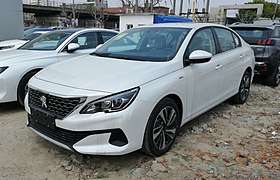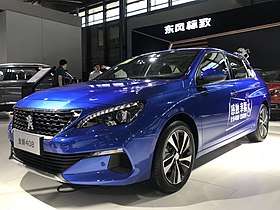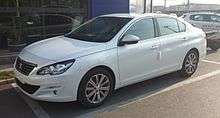Peugeot 408
The Peugeot 408 is a small family car produced by Peugeot. It was unveiled on January 25, 2010,[1] at the Beijing Auto Show and sales began in China on April 8, 2010.[2] In November 2010, production of the 408 commenced in El Palomar, Buenos Aires, Argentina,[3] with sales starting in April 2011.
| Peugeot 408 | |
|---|---|
 Peugeot 408 | |
| Overview | |
| Manufacturer | Peugeot |
| Production | 2010–present |
| Body and chassis | |
| Class | Small family car (C) |
| Body style | 4-door saloon |
| Layout | FF layout |
| Related | Peugeot 308 |
| Chronology | |
| Predecessor | Peugeot 307 Saloon |
Despite its name, it is not the successor to the Peugeot 407, but rather a long-wheelbase saloon version of the Peugeot 308 hatchback,[4] primarily targeted at emerging markets such as China.[5] The 408 is not slated for the Western European market, and not built there. Depending on where this car is produced, there are both internal and external differences.
The front of the car is one of the visible changes, but also the low rear end is different. Indeed, in some markets, there are cars with the front of the South American version and the back of the Chinese version. Inside the vehicle, the most noticeable difference is seen at the door.
First generation (2010–2014)
| First generation | |
|---|---|
2013 Peugeot 408 2.0 (Asian version) | |
| Overview | |
| Manufacturer | Peugeot |
| Production | 2010–2014 |
| Assembly | Argentina: El Palomar (PSA Argentina) China: Wuhan (DPCA) Malaysia: Gurun (NAM) Russia: Kaluga (PCMA Rus) |
| Body and chassis | |
| Class | Small family car (C) |
| Body style | 4-door saloon |
| Layout | FF layout |
| Platform | PSA PF2 platform |
| Related | Peugeot 308 Dongfeng Fengshen L60 |
| Powertrain | |
| Engine | 1.6 L TU5JP4 I4 Petrol 1.6L Prince Turbo I4 petrol 2.0 L EW10A+ I4 Petrol |
| Dimensions | |
| Wheelbase | 2,710 mm (106.7 in) |
| Length | 4,680 mm (184.3 in) |
| Width | 1,815 mm (71.5 in) |
| Height | 1,525 mm (60.0 in) |
| Chronology | |
| Predecessor | Peugeot 307 Saloon |
| Successor | Peugeot 408 (second generation) |
The 408 was available in China with either a 1.6 L and 2.0 L petrol four cylinder engine. The 1.6 (TU5JP4) has a capacity of 1587 cc and produces 110 bhp (82 kW; 112 PS) at 5,750 r.p.m. and maximum torque of 147 N⋅m (108 lb⋅ft) at 4,000 rpm. The 2.0 L(EW10A+) engine has a capacity of 1997 cc and produces 147 bhp (110 kW; 149 PS) at 6,000 rpm and 200 N⋅m (148 lb⋅ft) at 4,000 rpm.[6]
Either engine can be specified with a five speed manual or four speed automatic transmission.
In South America a 1.6 L diesel engine, known as a HDi (Allure, Feline/Griffe), is sold alongside the 2.0 L petrol engine (Allure, Feline/Griffe) and 1.6L THP petrol engine (Sport) with six speed automatic transmission. The four cylinder diesel has a capacity of 1560 cc and produces 143 bhp (107 kW; 145 PS) and torque of 240 N⋅m (177 lb⋅ft).
The HDi has a top speed of 188 km/h (116.8 mph) and accelerates to 100 km/h (62 mph) in 12.4 seconds.[7]
In Malaysia, 408 comes with two engines, 1.6L Prince turbo engine and 2.0L petrol four cylinder engine. The 1.6L engine produces 163 bhp (122 kW; 165 PS) at 6,000 rpm. and maximum torque of 240 N⋅m (177 lb⋅ft) from 1,400 rpm.
The 2.0 L (EW10A+) engine has a capacity of 1997 cc and produces 145 bhp (108 kW; 147 PS) at 6,000 rpm and 200 N⋅m (148 lb⋅ft) at 4,000 rpm. 1.6L Prince turbo engines mated with six speed and 2.0L engine mated with four speeds auto adaptive gearbox with Tiptronic and Sport mode only.
The first generation 408 continues in production in Latin America and Russia, with a front/rear (only front in Russia) facelift and minor changes. The front was restyled with grille, and headlamps in 408 style of the second generation 408.
Second generation (2014–present)
| Second generation | |
|---|---|
 2018 Peugeot 408 II (China) (facelift) | |
| Overview | |
| Manufacturer | Peugeot |
| Production | 2014–present 2016–2018 (Malaysia) |
| Assembly | China: Wuhan (DPCA) Malaysia: Gurun (NAM) |
| Body and chassis | |
| Class | Small family car (C) |
| Body style | 4-door saloon |
| Layout | Front-engine, front-wheel-drive |
| Platform | PSA EMP2 platform |
| Related | Peugeot 308 |
| Powertrain | |
| Engine | 1.6L EP6FDTM Prince Turbo I4 petrol |
| Transmission | 6-speed automatic |
| Dimensions | |
| Wheelbase | 2,730 mm (107.5 in) |
| Length | 4,750 mm (187.0 in) |
| Width | 1,820 mm (71.7 in) |
| Height | 1,488 mm (58.6 in) |
| Curb weight | 1,420 kg (3,130.6 lb) |
| Chronology | |
| Predecessor | Peugeot 408 (first generation) |



The second generation Peugeot 408 was unveiled in the 2014 Beijing Auto Show. In June 2016, the international version of the Peugeot 408 (known as Peugeot 408 e-THP) was launched at the NAZA Tower in Malaysia, though with only one engine choice and transmission.
A facelift was launched in 2018, featuring a redesigned front fascia, rear bumper, and tail lamps.
Performance and Environmental
Dynamic performance: 0 to 100 km/h: 8.2 s
- Fuel Consumption*: 8.3 L/100 km (34 mpg‑imp; 28 mpg‑US) (Urban), 5.5 L/100 km (51 mpg‑imp; 43 mpg‑US) (Extra Urban), and 6.5 L/100 km (43 mpg‑imp; 36 mpg‑US) (Combi)
- Greenhouse gas emission* (CO2): 200 g/km (11 oz/mi) (Urban), 131 g/km (7.4 oz/mi) (Extra Urban), and 156 g/km (8.9 oz/mi) (Combi)
* Test with New European Driving Cycle (NEDC)
References
- "408 in Beijing". Peugeot. 2010-01-25. Retrieved 2010-04-13.
- "Commercial launch of the Peugeot 408 in China". Peugeot. 2010-04-09. Retrieved 2010-04-13.
- "Automotive World 9 November 2010". Automotiveworld.com. 2010-11-09. Retrieved 2011-05-05.
- New Peugeot 408 launched Autocar 25 January 2010
- Commercial launch of the Peugeot 408 in China - Peugeot Press Release, 8 Apr 2010
- "Peugeot 408 press kit January 2010" (PDF). Retrieved 2011-05-05.
- "Peugeot Argentina website". Peugeot.com.ar. Retrieved 2011-05-05.